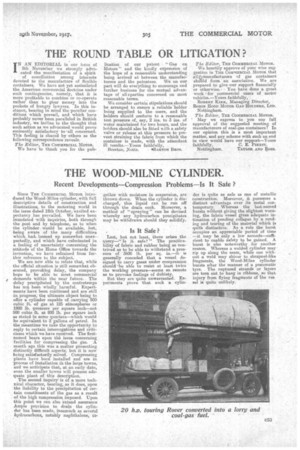THE WOOD-MILNE CYLINDER.
Page 19

If you've noticed an error in this article please click here to report it so we can fix it.
Recent Developments—Compression Problems—Is It Safe ?
Since Ties COMMERCIAL MOTOR introduced the Wood-Milne cylinder, with full descriptive details of constraction and illustrations, to the motoring world in the issue dated 18th October, excited expectancy has prevailed. We have been inundated with inquiries, both through the post and by telephone, as to when the cylinder would be available, but, being aware of the many difficulties which hack loomed up somewhat unex-pectedly, and which have culminated in a feeling of uncertainty concerning the attitude of the Home Office towards the invention, we have refrained from further reference to the subject.
We are now able to relate that, while the official situation is still somewhat obscured, provoking delay, the company hope to be able to meet commercial demands within the near future.. The delay precipitated by the contretemps has not been wholly harmful. Experiments-have been continued and are still in progress, tlm ultimate object being to offer a cylinder capable of carrying 500 cubic ft. of gas at 125 atmospheres or 1800. lb. pressure per square inch—not 500 cubic ft. at 800 lb. per square inch as stated in some parters--Which would be equivalent to 2 gallons of petrol. In the meantime we take the opportunity to reply to certain interrogations and crititisms which we have received. The firstnamed bears upon thli issue concerning facilities for compressing the gas. A month ago this was a matter presenting distinctly difficult aspects, but it is now being satisfactorily solved. Compressing plants have been installed and are in process of installation in the large towns, and we anticipate that, at an early date, even the smaller towns will possess adequate plant of this description. The second inquiry is of a more technical character, bearing, as it does, upon the liability to the precipitation of certain constituents of the gas as a result of the high Compression imposed. -Upon this point we can, also extend assurance Ample provision to drain the cylinder has been made, inasmuch as several
hydrocarbons, notably naphthalene, to . gether with moisture in suspension, are thrown down. When the cylinder is discharged, this liquid can be run off through the drain cock. Moreover, a method of "spraying" can he devised whereby any hydrocarbon precipitates may be withdrawn should they solidify.
Is It Safe ?
Last, but not least, there arises the
query—" Is safe? " The practicability of fabric and rubber being so contrived as to be able to withstand a. pressure of 3600 lb. per sq. in.—it is generally conceded that a veeset designed to carry gases under compression should 'he able to resist at least twice the working pressure—seems so remote as to provoke feelings of dubiety. But they are quite unwarranted. Experiments prove 'that such a cylin der is quite as safe as one of metallic construction. Moreover, it possesses a distinct advantage over its metal contemporary. Whereas the last-named bursts without giving the slightest warning, the fabric vessel gives adequate intimation of pending collapse by a rending and tearing of the material which is quire distinctive. As a rule the burst occupies an appreciable period of time --it may be only a few seconds—sufficient to enable safety to be gained. A burst is also noteworthy for another reason. Whereas a welded cylinder may • rip up along the seam, while one without a weld may shiver to shrapnel-like fragments, the Wood-Milne cylinder bursts after the manner of a pneumatic tyre. The ruptured strands or layers are torn out to hang in ribbons, so that injury from flying fragments of the yes sel is quite unlikely.
























